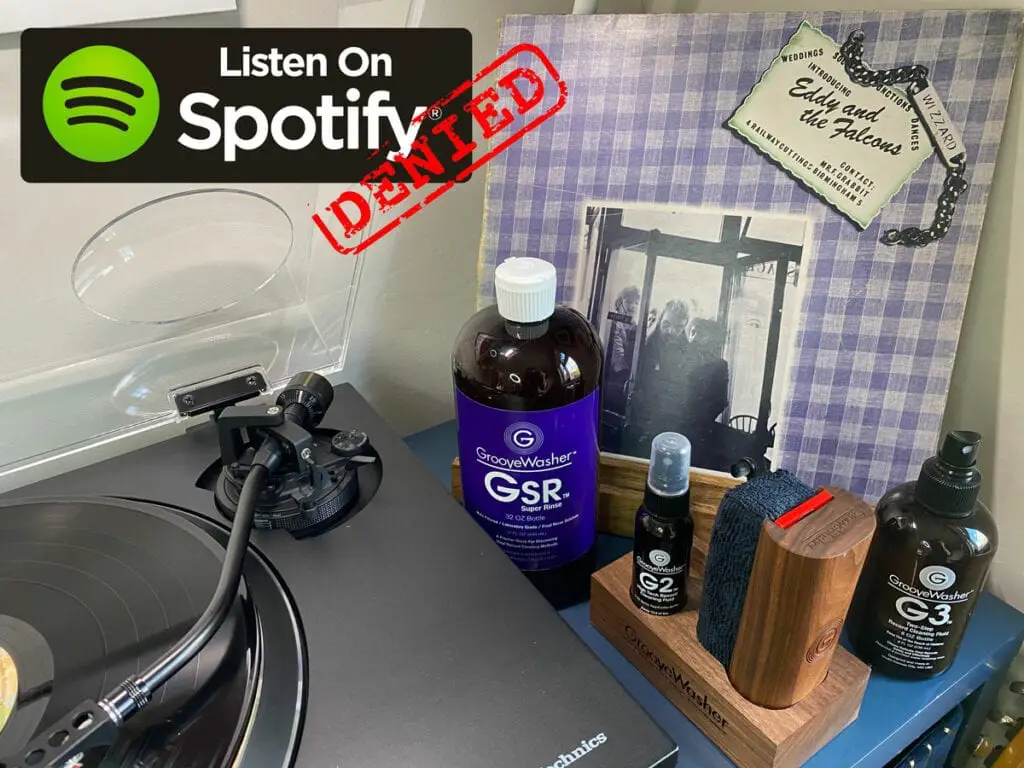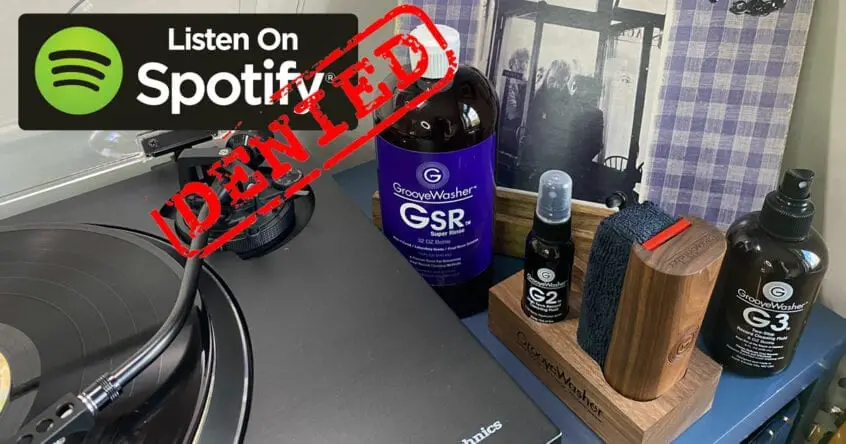Firstly, I’ll be honest, vinyl is my preferred music format, but I do own a subscription to the streaming platform Tidal.
In my opinion, vinyl is the best way to experience music, but there is a time and a place for digital streaming services. I mean, I can’t exactly take my vinyl with me on the train, and let’s be honest, there are times when background music doesn’t exactly justify spinning a record.
Music streaming services such as Spotify and Tidal have made music more accessible than ever. It can never replace the experience of collecting records (or even CDs), but there is something to be said for music discovery and unlimited access to decades of music history.

That being said, I was recently reminded of the shortfalls when talking to the owner of my local pub. He was telling me about a record he missed from his youth and how, while he’d gladly given up his record collection in favor of streaming, he couldn’t find the album in question on Spotify.
The album is Eddie and The Falcons by English glam rock band Wizzard. Fortunately, the town I live in has a pretty strong sense of community, and another pub regular was kind enough to seek out a vinyl copy for him as a gift.
Another catch… he’d also ditched the turntable, so could no longer play records. The album was in a pretty unloved state, with the inner sleeve missing and the album covered in years of dust. Long story short, I offered to clean the record up and digitize it for him.
This example is not the first time I’ve encountered albums that are not available on streaming platforms. A couple of examples that spring to mind from my own Discogs want list include The Buckingham Nicks album and a soundtrack containing several John Frusciante songs titled ‘The Brown Bunny’. I’m sure Sound Matters subscribers can name plenty of other examples. (Let us know in the comments).
For me, this represents one of the principal arguments for owning rather than renting music. There must be countless examples of older albums that may never make it to a streaming platform. In some cases, they might never have made it onto CD, let alone a digital download followed by Spotify and the likes.
You could argue supply and demand will dictate what makes the cut, but there’s no denying that some of these titles will eventually be lost forever (bar a few physical copies that might survive).
There are plenty of other reasons why owning the music you love is beneficial, least of all the sense of value and joy that comes from owning a record. Check out our article entitled ‘The Importance of Music Ownership’ to explore these further.
Transfering the Record to Digital Files
A successful digital recording of an LP is easier to achieve than you might think. While there are fewer reasons to digitize your LPs than perhaps there were during the peak of digital downloads, there are still occasions, such as this example, where it’s a great option.
First up. Clean the Record
The lasts thing you want to do is record a filthy record, and while there is very little you can do about any pops or clicks coming from scratches or groove wear, you want to capture the record as clean as possible.
The first thing I do is dry clean the record of as much loose surface dust as possible using a carbon fiber record brush before going anywhere near record cleaning fluid.
This is an important step, as wet cleaning over a visibly dusty record can make matters worse. The loose dust is pushed into the grooves and can then become much harder to remove. In short, never apply a sledgehammer to kill a fly when cleaning records. Start gentle and work your way up.
How to Correctly Use a Carbon Fiber Record Brush
Check out our full guide on this topic, here. But here’s the crux of it:
Gently hold the brush over the record so the carbon fibers just tickle the surface. Don’t squash the brushes; you want the fiber tips to penetrate the groove.
While holding the brush gently in place, allow the record to spin on the platter a few times.
Most of the dust will gather at the front fibers. Now, gently scoop up the front fibers allowing the rear set of fibers to catch anything missed by the front. Now lift the brush. Repeat this process if necessary.
In between each clean, you can use the handle to clear any collected dust by rocking the fibers back and forth through the handle.

Wet Cleaning
With as much dust removed as possible, we can now remove any stubborn grease, grime and finger marks by wet cleaning the record.
As the record surface was pretty dirty, I choose to use the new, stronger G3 record cleaning fluid from GrooveWasher. This cleaning fluid contains increased surfactant concentration for greater cleaning power when compared with the original G2 formula. However, this does require you to perform a secondary rinse step using their own GSR super rinse, or distilled water. Check out our full review of this product, here.

When deep cleaning a very dirty record, I like to take the vinyl away from my turntable. Place the record on a lint-free cloth (I use GrooveWashers microfiber landing towel), and follow the cleaning instructions as follows:
- Place the record label protector disk on the record label. Spray five or six mist sprays of G3 to cover the record surface completely. Wait 10 seconds or more.
- Set the cleaning pad base into the wood handle.
- Lightly apply the leading edge of the pad to the record and wipe the record in concentric arcs. (With the grooves – not across). Wipe the entire record at least three times with moderate pressure.
- Rotate the pad to gently dry and groom the surface.
- Allow the record to air dry, and then apply a generous amount of GSR Super Rinse while being careful not to soak the label. I recommend using a separate microfiber cloth for this rinsing step. A very fine e-cloth will improve the finish.
Digitizing the Record
Digitizing records on your computer is a big topic – one that’s best tackled by a separate article. You can read our complete guide to digitizing your vinyl records, here.
In short, you will need an ADC (analog to digital converter) or a USB audio interface. You will also need recording software. Some USB devices ship with basic software packages, plus there are a couple of purpose-designed suites out there for capturing vinyl records. Again, check our complete guide for the nuts and bolts of this process.

The Bottom Line
If you don’t own the physical copy of a record, it’s not yours for life. By handing over control of your entire music collection, you abandon any sentimental attachment or unique qualities.
Worst of all, if you stop searching for albums and artists, and instead rely on playlists and voice control to select your music, you become a passive listener without any individual taste or opinions.
This significant change in consumer listening habits has devalued the role of music in our society. Once at the forefront of popular art, fashion, and culture, music, arguably, has given way to other forces that now carry more weight in our society, such as internet culture, social media influencers, and reality TV stars.
To avoid music becoming a wallpaper backdrop to our daily activities—and instead remain a focus of importance and a meaningful form of entertainment—we must own the music we love.
Vinyl as a medium carries so much individuality. Every record has a story; every pressing is slightly different. Your copy is unique, right down to how you take care of it, how it ages, and the memories you associate with your copy. We lose all of this in the age of streaming.
The music hosted on Spotify cannot replace a record collection. Can’t find that album you love on their server? Tough, they’re in the driving seat now; you’re just another number and a recurring source of income.
The moral of the story? Use these services, by all means. But where possible, take the time to sit down and make music the focal point, rather than the secondary focus. Vinyl is the ideal format for active rather than passive music consumption as it demands your attention. From the moment you pull the record from its sleeve, it requires you to steer the ship. Long live music. Long live the vinyl record.




Years ago (50) I won a record in a raffle, a well worn Blue Note Blues compilation. If I could replace this LP with a newer one and also find the source LP for each of the songs I would be very happy.